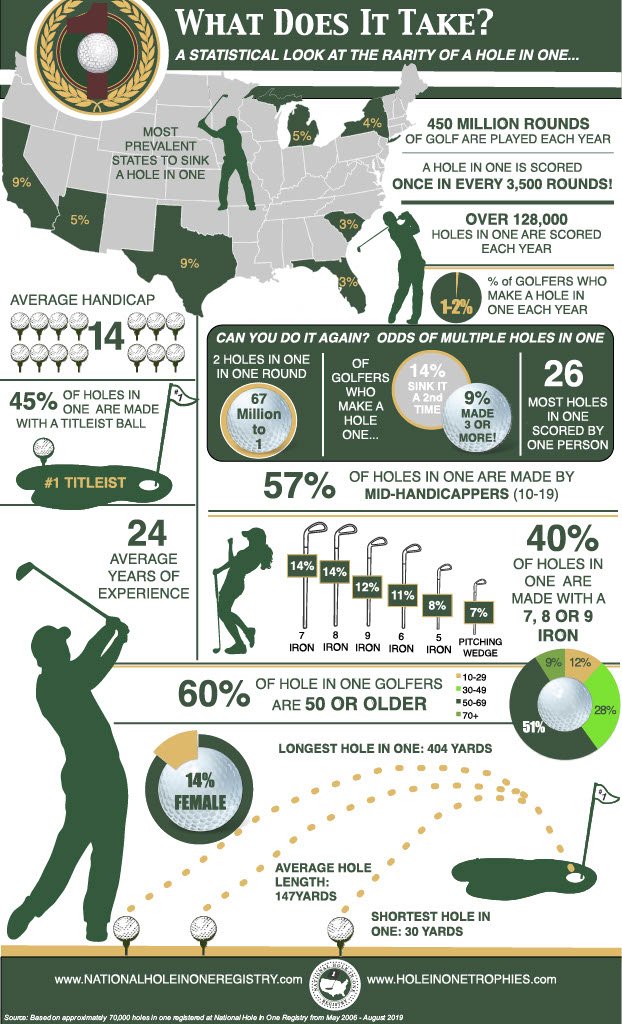Odds on hole in one

The chances of an average golfer getting a hole in one are quite low. According to the National Hole-in-One Registry, the odds of a professional. According to the National Hole-in-One Registry, the odds odds on hole in one the average golfer making a hole-in-one are 12, to 1. Broken down even further. On the contrary, if you're a scratch golfer who shoots in the 70s, the average hole-in-one comes about every seven years; or after rounds. The National Hole-in-One Registry says that the odds of a PGA Tour pro getting a hole in one is 3,to (It also says the 'average' golfer.
What are the odds of hitting a hole-in-one?
Looking into the stats a little more, about half of these shots are with a seven iron or shorter. Unsurprisingly, the longer the hole, the less likely it is that you make 1. Likewise, your chances of making a hole in one are greater if you are a man and if you are a lower handicap golfer.
More men play golf than women and lower handicap golfers tend to play more often, so both of these facts tend to skew the statistics somewhat. Our number of to 1 does seem to give a fairly definitive answer to the question, but I decided to dig a little bit deeper. For example, this statistic is quoted for golfers everywhere but is based on reported statistics from the USA.
Likewise, what do you do with a hole in one when a golfer is hitting a couple of balls in a practice round as I often do. The fact that these figures are from the USA only also changes things. Are we more or less likely to make a hole in one outside of the USA. The odds are going to be essentially the same on golf course the world over.
In many parts of the world, bookmakers will offer odds on anything and you can bet that these odds will be the result of a fair bit of statistical study. The odds offered seem to be fairly consistent with something north of to 1 being the standard. If you are thinking that it seems easier than this, here is something to think about.
The European Golf Tour produces a lot of great content on YouTube, notably their series of challenges. But for your average golfer. Let's go to the scorecard:. Which sounds like a lot. Except golfers play somewhere around million rounds of golf every year. That means a hole-in-one is officially registered about once every 3, rounds.
A round is generally considered 18 holes , though the United States Golf Association sometimes accepts a hole-in-one on a shortened round. Odds on hole in one If you play a round of golf a day, it'd take more than 9. If you play twice a week, it'd take you more than Another business, National Hole-In-One Insurance — it provides protection to golf courses that give out prizes for holes-in-ones during competitions — estimates that, for your average player, the odds of holing out in one stroke are 12, to 1.
On every chance at an ace. The numbers, undoubtedly, are a little sketchy. The USGA isn't exactly looking over every golfer's shoulder. Video proof is not required. A credible witness is about all you need. And for some of the more amazing stories, the odds are just as incredible. For example, in a European Tour pro hit back-to-back aces one of them a par-4 at odds of 50 million to 1.
And at the U. Open, four pros aced the same hole — number six — during the second round. Odds: 1.  Just provide us with your email address and get monthly offers, specials, news and more. Guaranteed spam free. Toggle navigation. Michael J. How often should you service your electric buggy?
Just provide us with your email address and get monthly offers, specials, news and more. Guaranteed spam free. Toggle navigation. Michael J. How often should you service your electric buggy?
Popular Pages
- Max homa odds
- Disc golf betting cool
- Betfair golf odds
- 2021 waste management open leaderboard
- Golf bet made millions
- Dubai desert classic golf betting tips
- Alfa beta charlie delta echo fanta golf indonesia
- To lift the trophy bet meaning
- Action golf bet
- Mexico open odds
- Jason day masters odds
- Where to bet on golf online
- Ti tech beta golf balls reviews
- Bmw championship promo code
- Golf bets for fivesomes